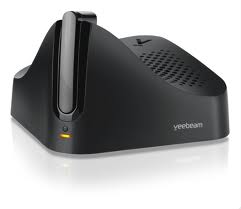Veebeam starts with a simple yet elegant concept. There’s content on your computer. You want it on your TV. You don’t want wires running all over your house, and Veebeam claims to help you with that desire. Unfortunately, Veebeam’s execution leaves a lot to be desired.
Veebeam comes with a USB device for your computer and an elegant little set-top box for your TV. The setup is simple enough. Download the software, hook up the box to your TV (composite audio/video for either SD or HD version, with an HDMI option for the Veebeam HD), plug the USB adapter into your computer, and you’re ready to go. It works with Mac OS X (10.5 and 10.6, no word on 10.7 Lion yet) or Windows (XP, Vista, or 7).
Veebeam also has two modes of operation. By default, it operates in Screencasting Mode, simply duplicating whatever is on your computer screen. If you plan on using Veebeam to watch Netflix streaming or Hulu, this is the mode you use. Unfortunately, Veebeam makes no allowances for different aspect ratios. If you have an old 4:3 monitor and a widescreen TV, you won’t be able to see the bottom of whatever you’re watching.
If you want to watch video files from your computer’s hard drive, there is a better option, called Video Play-To Mode. This mode allows you to use your computer while watching video totally separately on your TV.
For both options, your mileage varies based on how powerful your PC is. A 2.93 GHz Core 2 Duo with 4 GB of RAM normally has no trouble handling HD video in 1080p, and it’s well within Veebeam’s system requirements. But it only gets one out of three stars in Veebeam’s compatibility tester, and the results show why. Colors are washed out in Screencasting Mode, while Video Play-To Mode has significantly reduced playback quality. And by “significantly”, I mean the results are about the same as playing video through a VGA cable.
Veebeam is certainly priced a lot better than a lot of media extenders on the market right now. It’s $90 for a Veebeam SD and an extra $10 for the HD version. Even cheap, I don’t think it’s worth the price for most users. Veebeam doesn’t provide any practical functionality you can’t get with an Xbox 360 and a home WiFi network, and I imagine most anyone with a powerful enough PC to actually get 1080p video out of a Veebeam already has a media extender of some kind. If you don’t, you’re probably better off with something like a Roku. You can’t duplicate your PC’s screen or play your desktop media files with a Roku, but $60 gets you access to all the same streaming services as the Veebeam, directly on your TV.
More to the point, Roku and many of the other competitors work. Veebeam is still just trying.




Comments are closed.